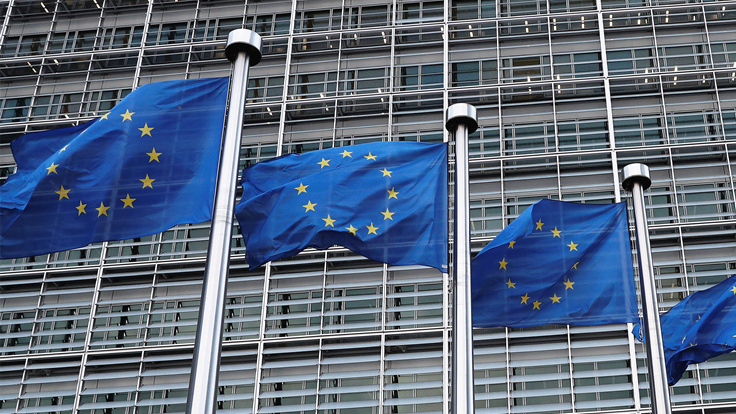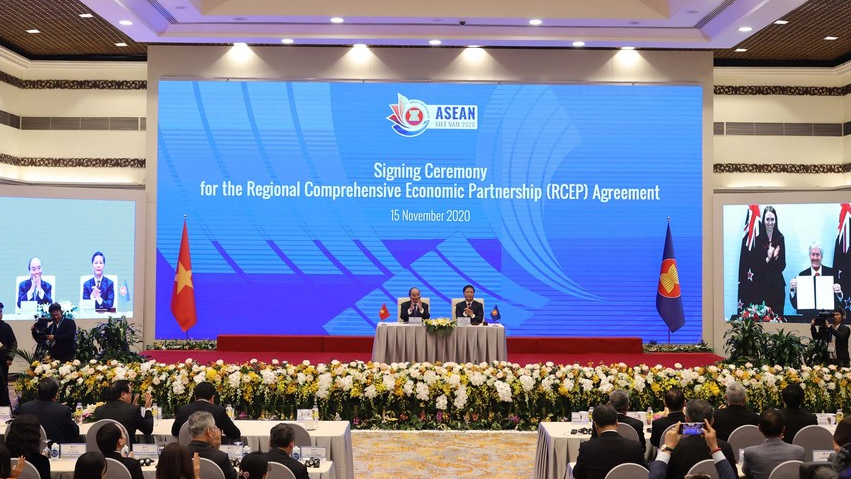
European Union flags flutter outside the EU Commission headquarters in Brussels, Belgium, March 8, 2018. /Reuters
European Union flags flutter outside the EU Commission headquarters in Brussels, Belgium, March 8, 2018. /Reuters
Editor's note: Hannan Hussain is a foreign affairs commentator and author. He is a Fulbright recipient at the University of Maryland in the U.S., and a former assistant researcher at Islamabad Policy Research Institute. The article reflects the author's opinions and not necessarily the views of CGTN.
On April 19, all 27 European Union (EU) member states formally adopted the "EU Strategy for Cooperation in the Indo-Pacific" during a Foreign Affairs Council meeting. The 10-page document aligns the union's "strategic focus, presence and actions" toward the Indo-Pacific by putting regional security, trade cooperation, supply chain support, and coordinated maritime consensus at the heart of a "principled" global actor role. In a subtle departure from U.S.-backed containment theatrics, the EU's regional commitment is focused more on bringing "added value" to all of its existing bilateral and multilateral relations in the region. These determinations underline a degree of inclusivity, as well as vigilance of countries' firm territorial and sovereign red-lines.
However, successful enforcement of the EU's role as a "cooperative partner" in the Indo-Pacific would merit statecraft on three key fronts.
Regional architecture for maritime peace
The assumptions associated with the new EU strategy include an increase in geopolitical competition, along with the risks afforded to "free and open" maritime supply routes, maritime domain awareness, and rules-based "freedom of navigation." But Brussels must note that these strategic rationales are not new, and have been tapped by Washington and Tokyo to undercut a regionally acknowledged ASEAN-China maritime code of conduct build-up. Therefore, EU advocacy for maritime peace is welcome, but it should be founded on the advancement of indigenous dialogue between legitimate territorial parties of the region.
It is here that the EU's interests are best served by ruling out its implementation of the Critical Maritime Routes Indian Ocean (CRIMARIO) framework. This is because the framework puts a premium on "maritime surveillance, policing, investigation and judicial matters," effectively presuming peace in Asia is best served as a foreign import.
Similarly, the EU's defense for a "meaningful European naval presence" in the region risks undesirable blowback. First, the EU's long-term peace-making goals in Asia could be captured as unmistakably unilateral, should such naval presence persist. Second, any unilateralism can put a slew of promising EU cooperation frameworks on ice: the EU's "Enhancing Security Cooperation in and with Asia" project, and its strategic partnership with ASEAN. Both these frameworks could carry limited value for Asian maritime security concerns, once Brussels operates outside the confines of a dialogue-based contribution.
Economic connectivity at the center of Asia policy
Built into the EU's Indo-Pacific strategy is a resolve to set clear priorities on "digital, transport, energy and human" connectivity. Member states offer evidence of expanding such economic connectivity to the broader advantage of Eurasian ties, pointing to the G20 Principles for Quality Infrastructure Investment, fast-tracking of high-value trade pacts with Beijing and Jakarta, and the tempering of Western exceptionalism by building on ambitious trade precedents such as the Comprehensive and Progressive Agreement for Trans-Pacific Partnership (CPTPP) and the Regional Comprehensive Economic Partnership (RCEP).

The signing ceremony of the Regional Comprehensive Economic Partnership (RCEP) agreement is held via video conference in Hanoi, Vietnam, November 15, 2020. /Xinhua
The signing ceremony of the Regional Comprehensive Economic Partnership (RCEP) agreement is held via video conference in Hanoi, Vietnam, November 15, 2020. /Xinhua
As years of multilateral negotiations made clear, the likes of RCEP were born out of an equal stake for each signatory in benefiting from the region's supply chain resilience, without trade and foreign investment barriers looming large over smaller economies. This is an important consideration, because the EU's notion of advancing its "economic agenda" in Asia is predicated on the assumption that its "strategic trade position" is insured against exploitation.
To the EU's benefit, China has already shown how free trade guarantees can be negotiated under the Comprehensive Agreement on Investment (CAI). An inherently apolitical approach to Asia could offer even wider latitude for free trade gains and rights protection for Brussels.
Common interests, not 'like-minded' democracies
Brussels' stated contribution to Asia's economic governance and regional security is tied to "like-minded" partners. But as part of its Indo-Pacific strategy suggests, it would be a mistake to confine that economic and security convergence to only a Western-style democratic construct.
The clearest sign yet is that the EU will adapt its cooperation style to "specific policy areas" that are agreed on shared principles with a diverse cluster of regional stakeholders. As such, the union singles out no particular regime type in its Indo-Pacific strategy, nor does it shy away from expanding geographic limits from Asia to Africa's east.
However, to be clear, the same strategy must merit rectification in Brussels, particularly over some stand-out contradictions built into it: a stated preference for cooperation with countries that have "Indo-Pacific approaches of their own," and a more assertive tone on human rights, despite humanitarian freedoms being governed by a country's sovereign social contract.
All that is to say that the Western-backed "Indo-Pacific" notion is still very exclusive by design, and the EU's best bet is to offer a buffer against unwarranted containment tendencies. But Brussels' substantive orbit of sovereign allies, attractive market presence, and admirable commitment to peace-building worldwide can take Eurasian cooperation to newer heights – well beyond the reductive confines of the Indo-Pacific model.
(If you want to contribute and have specific expertise, please contact us at opinions@cgtn.com.)

